This post is one in a series following six brewers collaborating to each make a small adjustment to a single recipe in order to improve it, then pass it along to the next brewer. We hope to learn more about the art of recipe creation as we see how other brewers approach the same recipe. The rest of the series can be found here.
Author: M. Rasmussen
Brew Day
There was a lot going on with this brew day. I brewed an 8 gallon batch because I’m in the process of teaching a couple of friends how to homebrew. I was documenting as much as I possibly could— far more than I normally document. My regular brewing partner was brewing 5 gallons of a blonde ale right next to our 8 gallons of stout. And, of course, there was pizza and plenty of beer in the mix. That being said, this was one of my more successful brew days when it came to hitting all of the numbers.
I use a BIAB setup with a 16 gallon kettle, BrewBag, propane burner, ladder + pulley system, and a plastic wide-mouth fermenter. I’ve only ever brewed an 8 gallon batch a few times, so I was very meticulous when crafting the recipe in BeerSmith and throughout brew day. I’ve yet to get into buying grains in bulk, so my brewing process started out with a trip to the local homebrew store to pick up the grain bill and some yeast. I usually like to do a full yeast starter, but since I didn’t know the recipe until the day before brew day, I had to shorten my process a bit. I got a vitality starter going the night before brew day so the yeast would be awake, plentiful, and in their groove when they hit the beer.
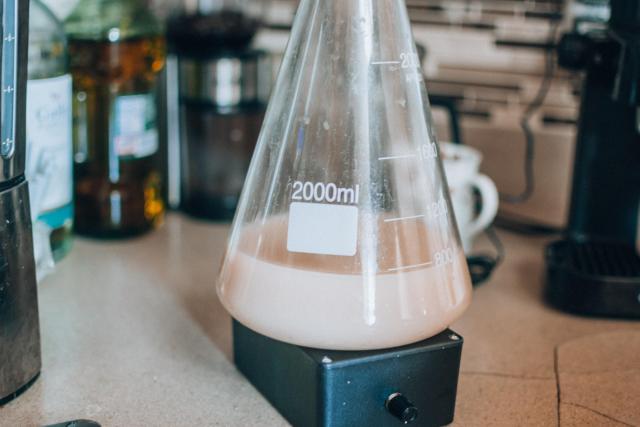
I also collected my gear and measured all of the water the night before to make brew day that much smoother. After setting up the brew station, I dosed the water with 5oz of gypsum, 2.5oz of calcium chloride and 1.5oz of lactic acid to hit a pH of 5.4, according to my Bru’n water spreadsheet.
Once the 10 gallons of mash water got up to temp, it was time to dough in. The mash smelled incredible. All of the dark and roasted malts created one of the richest and chocolatey mashes I’ve ever been around. I hit the mash temperature dead on.
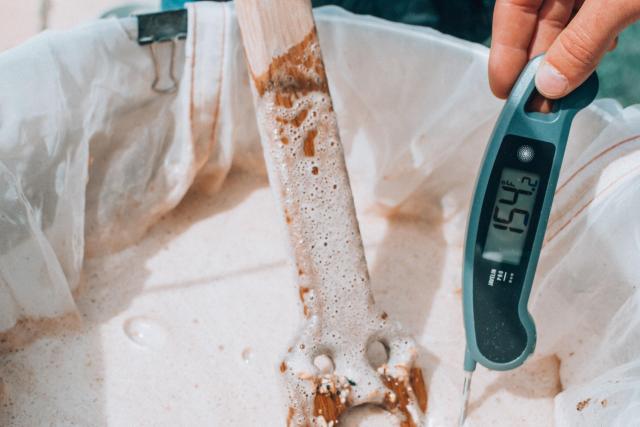
After ten minutes of mashing, I checked the pH and it was right on target. Throughout the 60 minute mash, I went back a few times to stir and reheat to maintain the most efficient extraction possible. After the mash, I raised the bag, rinsed the grain to get back up to my pre-boil volume, and squeezed the bag.
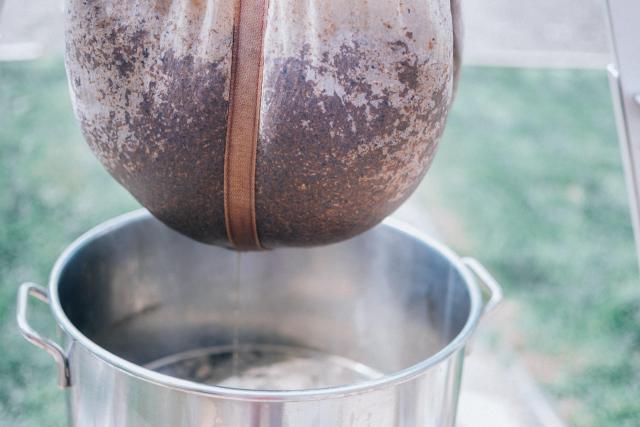
I overshot the pre-boil gravity by 2 points, so I added a little bit of water to dilute the wort.
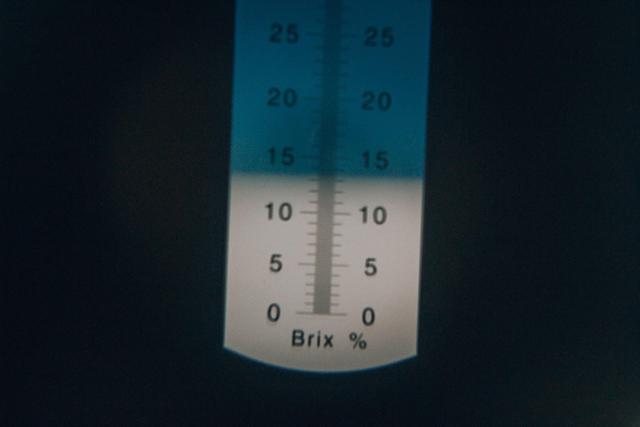
The boil went smoothly. I use Fermcap to keep my risk of boil-overs as low as possible. With this rich and sugary of a wort, it was almost not enough. I never actually boiled over, but it got up to the rim a few times. I added the Nugget hop charge at 60 minutes, whirlfloc and my stainless steel immersion chiller went in at 15 minutes, and then the Willamette charge went in at 5 minutes.
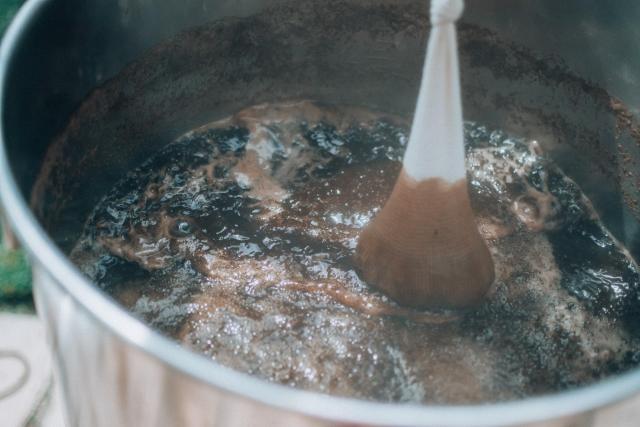
I checked the gravity right before I cut the flame, and I still came in one point high. My groundwater was nice and cold that morning, so the wort was chilled within 20 minutes. I use a spray aerator during the transfer to my fermenter to introduce oxygen. Once the beer was transferred, I took a few seconds to admire the beauty of such a dark wort.
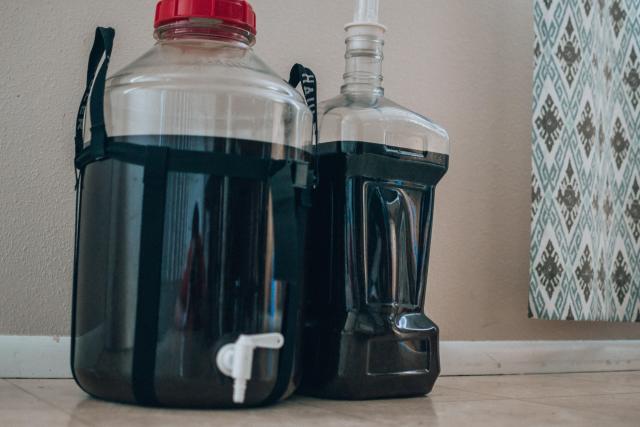
After sitting in my fermentation chamber for a few hours, the wort was at my fermentation temperature of 66 degrees, so I pitched the yeast. I noticed signs of active fermentation the next morning. Krausen fell and activity slowed down about 60 hours later. The beer sat at 72 degrees while I was out of town for the weekend. Ten days after pitching the yeast, I started the cold crash, and the next day I kegged the beer.
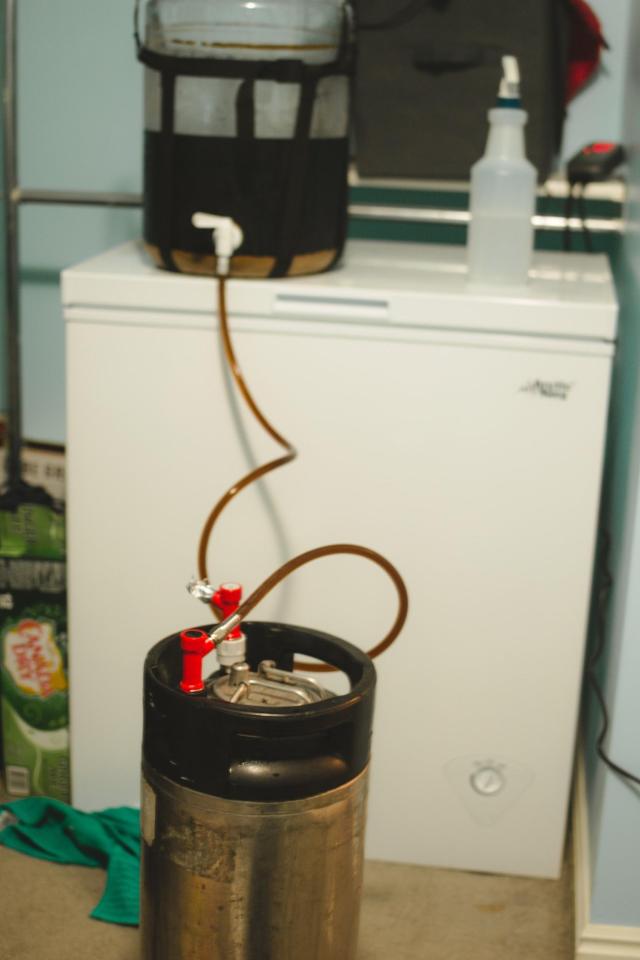
I pulled a hydrometer sample to check the final gravity right before transferring to the keg. BeerSmith estimated an FG of 1.018, but the hydrometer was reading 1.024. I tasted the sample, and it definitely didn’t taste as sweet as the hydrometer suggested. So I grabbed my refractometer and plugged that reading into four different post-fermentation refractometer calculators. They all gave me the same FG of 1.018; I think I’ll forgo using that hydrometer in the future. I’m much too impatient to carbonate the traditional way, so I set my regulator to 50 PSI and let it sit overnight. In the morning I reduced the pressure to 10 PSI, relieved the pressure in the keg and let it sit while I went to work. Twelve days after brew day, I poured my first glass.
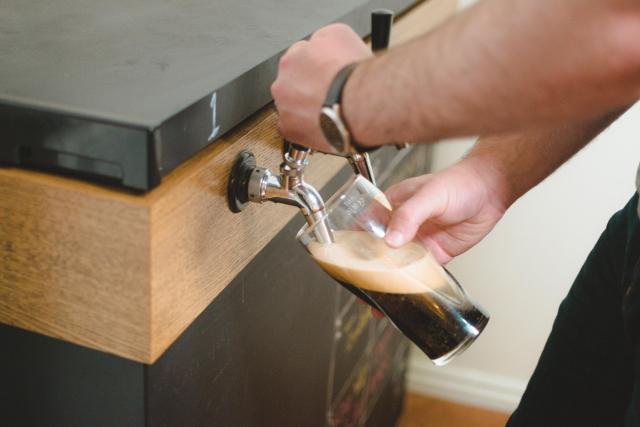
Recipe
Tasting notes from Iteration 5:
Appearance: Dark black. Resembles pitch or tar. Opaque, even when held up to direct light. Upon pouring, a thin head formed around the rim of the glass. The small head was tan and dissipated very quickly. Upon drinking, there was a nice lacing of off-white bubbles down the sides of the glass.
Aroma: Just after pouring (at 38°F) I got hints of vanilla, hazelnut, and chocolate. It was reminiscent of American sweet/milk stouts I’ve tried. There was also a bit of alcohol sharpness on the nose at first. After warming about 10 or 12 degrees, the aroma transformed into heavy notes of caramel, blonde roast coffee, and stone fruits—mainly plum.
Flavor: The main flavor at first was a heavy hit of roasted malt. There was a slight warming from the alcohol as it finished. It was a decently smooth flavor, but there wasn’t a lot of complexity. I didn’t pick up any flavor from the hops. As it warmed, the stone fruit, caramel, and chocolate notes from the aroma came out to play.
Mouthfeel: Carbonation level was perfect for a stout. It had a nice medium body, but I still would have liked a little more.
Aftertaste: Slight astringency at first. Most likely from the heavy use of roasted malt. As it warmed, the astringency mellowed out into a coffee-like bitterness. The caramel notes were more expressive once the beer reached 50°F.
Overall, I thought this beer was pretty decent. It had the makings of a really good stout, but there were a few things that fell short of making it a memorable beer. The heavy roasted notes, lack of hop character, slightly thinner body, and lack of overall complexity were all on my mind as I thought of what to change about the recipe. The grain bill had been changed in every iteration except one, so I didn’t want to fiddle with that again until the other aspects had been addressed. It didn’t take me long to decide that I wanted to use a different yeast. The Chico strain has so many strengths, but I felt that this beer was desperate for a yeast strain that was made to accentuate the level of dark/roasted malts in this bill.
Recipe:
- Mashed at 154° for 60 minutes
- 69.2% 2-row
- 10.8% Victory
- 7.8% Flaked Barley
- 7.8% Roasted Barley
- 4.4% Chocolate (300°L)
- Boiled for 60 minutes
- 1.6 oz Nugget (60 min.) at 12.4% AA (45 IBUs)
- 1.7 oz Willamette (5 min.) at 4.6% AA (3.6 IBUs)
- Pitched a vitality starter of White Labs Irish Ale Yeast (WLP004)
- OG: 1.065
- FG: 1.018
- ABV: 6.2%
Tasting
Iteration 6 tasting notes:
Appearance: Just as black and opaque as the previous version. No surprise there. There was a thick, off-white head. Not nearly as tan as before. Head retention was still pretty low. Dissipated quickly but still laced the glass nicely.
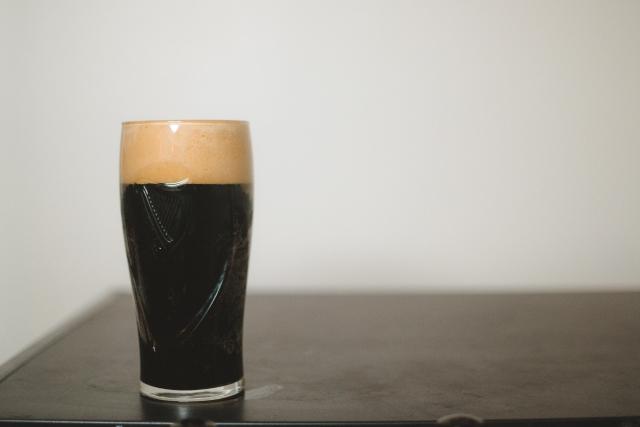
Aroma: Raisin and stone fruit—plum again. Faint roasted notes with hints of coffee and vanilla. After warming the vanilla and stone fruit is more expressive, and there are some esters from the new yeast.
Flavor: Much more complex. Still very malt-forward, but the punch of roasted malt is lessened. I tasted darkened toast or a slightly burnt biscuit. The flavor reminded me of the chocolate bread that you get at The Cheesecake Factory. There was still a slight warming from the alcohol when swallowing. After warming up, the caramel notes that I got so much in the previous version came out. I got vanilla and some milk chocolate flavors as well, but no coffee notes.
Mouthfeel: Pillowy and fluffy. Carbonation was light, just as a stout should be. The body was still medium, maybe medium-light.
Aftertaste: Slight astringency when still cold. Not quite as sharp as the previous version. Maybe this was the hop character peeking through the malt? After warming up, the astringency dissipated and the aftertaste was sweet and smooth.
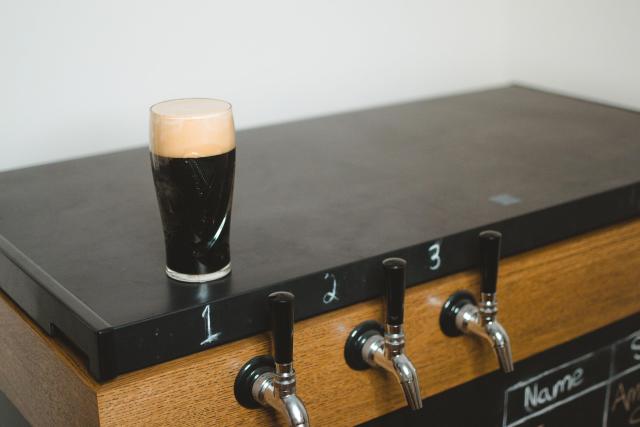
I’m very happy with this beer. It’s a decent stout straight from a cold tap, but this is the kind of beer that begs to be served at 50 degrees (Fahrenheit). The change in yeast did exactly what I expected by bringing out more complex aromas and flavors. I still would like to be able to taste and/or smell the hops in this beer, and I think one or two tweaks to the grain bill could be made to increase the body & head retention and bring out more chocolate & coffee flavors.
Recipe Progression
| Iteration 1 | Iteration 2 | Iteration 3 | Iteration 4 | Iteration 5 | Iteration 6 | |
| Base Malt 2-row | 80% | 80% | 80% | 72.5% | 69.2% | 69.2% |
| Specialty Malt 1 | 10% Victory | 10% Victory | 5% Victory | 10.8% | 10.8% | 10.8% |
| Specialty Malt 2 | 5% Roasted Barley | 5% Roasted Barley | 10% Roasted Barley | 4.4% Roasted Barley | 7.8% Roasted Barley | 7.8% Roasted Barley |
| Specialty Malt 3 | 5% Carafa III | 5% Chocolate Malt | 5 % Chocolate Malt | 4.4% Chocolate Malt | 4.4% Chocolate Malt | 4.4% Chocolate Malt |
| Specialty Malt 4 | None | None | None | 7.8% Flaked Barley | 7.8% Flaked Barley | 7.8% Flaked Barley |
| 60 min. hop | Nugget: 47.7 IBUs | Nugget: 42.5 IBUs | Nugget: 47.6 IBUs | Nugget: 41.2 IBUs | Nugget: 41.5 IBUs | Nugget: 45 IBUs |
| 5 min. hop | Willamette: 3.6 IBUs | Willamette: 3.3 IBUs | Willamette: 2.9 IBUs | Willamette: 3 IBUs | Willamette: 3 IBUs | Willamette: 3.6 IBUs |
| Yeast | US-05 | US-05 | US-05 | US-05 | US-05 | White Labs Irish Ale Yeast (WLP004) |
| OG | 1.054 | 1.060 | 1.045 | 1.065 | 1.064 | 1.65 |
| FG | 1.010 | 1.016 | 1.005 | 10.20 | 1.020 | 1.018 |
| ABV | 5.8% | 5.8% | 5.25% | 5.9% | 5.8% | 6.2% |

Pingback: Stout: Tasting Iterations 5 & 6 | brewublog
Pingback: Stout: Iteration 7 | brewublog
Pingback: Stout: Tasting Iterations 6 & 7 | brewublog
Pingback: Stout: Iteration 10 | brewublog
Pingback: Stout Iteration 12 | brewublog